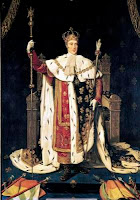 The barricades were thrown up no less than eight times between 1827 and 1849 in Paris' Faubourg St. Antoine. In 1830, street battles between the people and the king's forces resulted in Les Trois Glorieuses (July 27-29), three days of insurrection that would send then King Charles X packing and bring down the Bourbon Monarchy forever...
The barricades were thrown up no less than eight times between 1827 and 1849 in Paris' Faubourg St. Antoine. In 1830, street battles between the people and the king's forces resulted in Les Trois Glorieuses (July 27-29), three days of insurrection that would send then King Charles X packing and bring down the Bourbon Monarchy forever...
Once Emperor Napoleon Bonaparte was exiled on St. Helena, in 1815, the monarchy held by the Bourbon family since 1553, and thought to have ended with the beheading of Louis XVI in 1793, was restored. The next eldest brother of Louis XVI came to the throne as Louis XVIII*. Louis XVIII ruled as a constitutional monarch for 10 years, until 1824. When he died, the crown passed to his younger brother, the Comte d'Artois, who became King Charles X. The period of their combined rule (1814-1830) is known as the Bourbon Restoration.
Now Louis XVIII was fairly agreeable about ruling under a constitution. But his brother, the Comte d'Artois, was an "ultra-Royalist" and as soon as he became king, he began to roll back the civic gains of the preceding 40 years. He passed laws intended to increase the power of the nobility and clergy once again. On 6 July 1830 he sought to suspend the Constitution. And on 25 July he issued four ordinances powerful enough to launch French society back to its pre-Revolution days altogether: He repealed the freedom of the press as well as universal male suffrage. Under Charles X, whose ordinances also called for a September election that year, only wealthy land-owners would, once again, be allowed the vote.
 The people erupted. Students, poor, working class, and petty bourgeois alike stood shoulder to shoulder as they heaved paving stones, felled trees, furniture, even tipped carriages, anything that would serve to barricade Paris' narrow eastern streets against the king's advancing troops. For three "glorious" days they fought nobly to defend the gains of their fore-fathers. At the end of the third day, Paris erupted again, but this time in cheers as Charles X abdicated and fled France forever.
The people erupted. Students, poor, working class, and petty bourgeois alike stood shoulder to shoulder as they heaved paving stones, felled trees, furniture, even tipped carriages, anything that would serve to barricade Paris' narrow eastern streets against the king's advancing troops. For three "glorious" days they fought nobly to defend the gains of their fore-fathers. At the end of the third day, Paris erupted again, but this time in cheers as Charles X abdicated and fled France forever.
The king left his native land with instructions to make his 10-year-old grandson king, and that his cousin Louis-Philippe, duc d'Orleans, should rule as regent until the king's 13th birthday. But Louis-Philippe ignored these wishes and on August 9 colluded with the Chamber of Deputies to become the next (and last) King of the French.
So in 1830 France still had a monarch, but rule had shifted from the Bourbon to the Orleans branch of the royal family, something the Orleans had long desired. Their power, however, would last only as long as the next revolution...
*Louis XVII, first son of Louis XVI, died in captivity in 1795 at the age of 11, a victim of the French Revolution.
Images:
Ingres, Jean Auguste Dominique, King Charles X of France and of Navarre in Coronation Robes, 1829.
Delacroix, Eugene Ferdinand Victor, Liberty Leading her People, 1830.
 Wednesday, June 9, 2010 at 7:11AM Tweet
Wednesday, June 9, 2010 at 7:11AM Tweet 
 Check out the cannon shot still embedded in the facade above the 1st floor mullioned window: a très cool souvenir from Les Trois Glorieuses of 27-29 July 1830.
Check out the cannon shot still embedded in the facade above the 1st floor mullioned window: a très cool souvenir from Les Trois Glorieuses of 27-29 July 1830.
 Post a Comment | |
Post a Comment | |  Email Article |
Email Article |  Print Article | tagged
Print Article | tagged  Barricades,
Barricades,  Charles X,
Charles X,  Hotel de Sens,
Hotel de Sens,  July Revolution,
July Revolution,  Les Trois Glorieuses |
Les Trois Glorieuses |  Permalink
Permalink 






